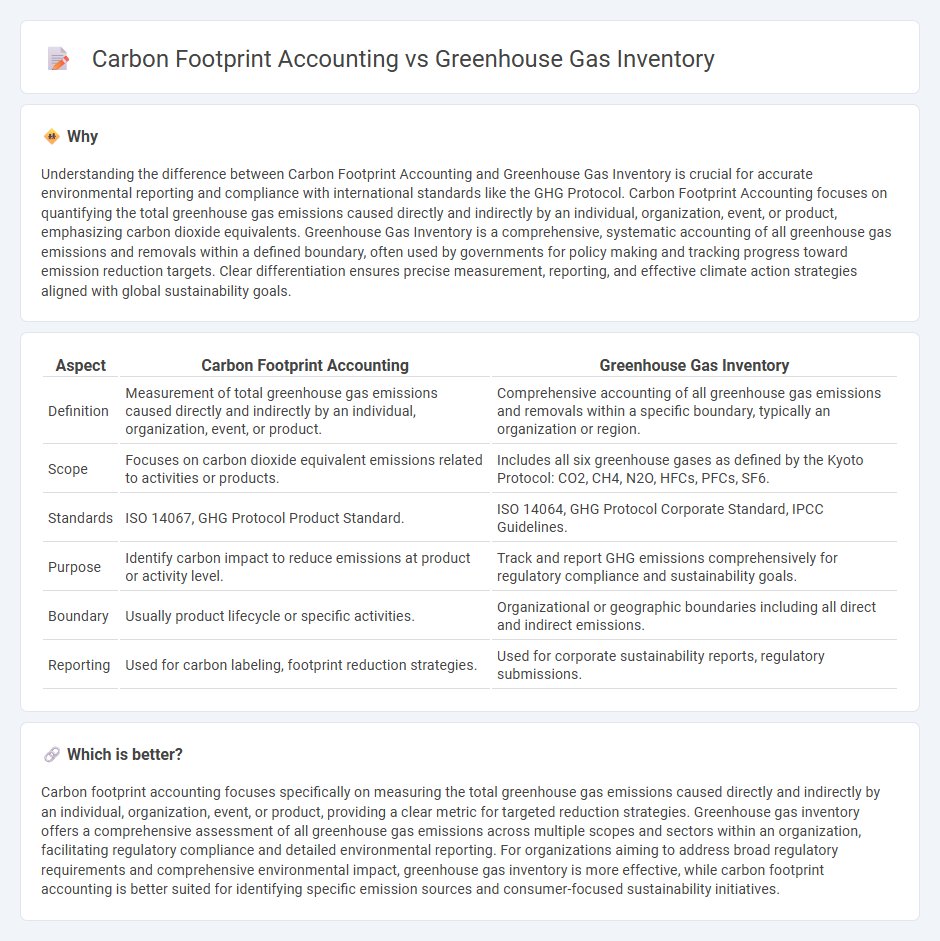
Carbon footprint accounting quantifies the total greenhouse gas (GHG) emissions directly and indirectly caused by an individual, organization, or product, focusing on carbon dioxide equivalents (CO2e). A greenhouse gas inventory systematically records and reports all GHG emissions and removals within a specific boundary, typically for regulatory compliance or sustainability reporting. Explore the distinctions and applications of these methodologies to enhance environmental accountability.
Why it is important
Understanding the difference between Carbon Footprint Accounting and Greenhouse Gas Inventory is crucial for accurate environmental reporting and compliance with international standards like the GHG Protocol. Carbon Footprint Accounting focuses on quantifying the total greenhouse gas emissions caused directly and indirectly by an individual, organization, event, or product, emphasizing carbon dioxide equivalents. Greenhouse Gas Inventory is a comprehensive, systematic accounting of all greenhouse gas emissions and removals within a defined boundary, often used by governments for policy making and tracking progress toward emission reduction targets. Clear differentiation ensures precise measurement, reporting, and effective climate action strategies aligned with global sustainability goals.
Comparison Table
| Aspect | Carbon Footprint Accounting | Greenhouse Gas Inventory |
|---|---|---|
| Definition | Measurement of total greenhouse gas emissions caused directly and indirectly by an individual, organization, event, or product. | Comprehensive accounting of all greenhouse gas emissions and removals within a specific boundary, typically an organization or region. |
| Scope | Focuses on carbon dioxide equivalent emissions related to activities or products. | Includes all six greenhouse gases as defined by the Kyoto Protocol: CO2, CH4, N2O, HFCs, PFCs, SF6. |
| Standards | ISO 14067, GHG Protocol Product Standard. | ISO 14064, GHG Protocol Corporate Standard, IPCC Guidelines. |
| Purpose | Identify carbon impact to reduce emissions at product or activity level. | Track and report GHG emissions comprehensively for regulatory compliance and sustainability goals. |
| Boundary | Usually product lifecycle or specific activities. | Organizational or geographic boundaries including all direct and indirect emissions. |
| Reporting | Used for carbon labeling, footprint reduction strategies. | Used for corporate sustainability reports, regulatory submissions. |
Which is better?
Carbon footprint accounting focuses specifically on measuring the total greenhouse gas emissions caused directly and indirectly by an individual, organization, event, or product, providing a clear metric for targeted reduction strategies. Greenhouse gas inventory offers a comprehensive assessment of all greenhouse gas emissions across multiple scopes and sectors within an organization, facilitating regulatory compliance and detailed environmental reporting. For organizations aiming to address broad regulatory requirements and comprehensive environmental impact, greenhouse gas inventory is more effective, while carbon footprint accounting is better suited for identifying specific emission sources and consumer-focused sustainability initiatives.
Connection
Carbon footprint accounting quantifies the total greenhouse gas emissions produced directly and indirectly by an organization, serving as the foundational data for a comprehensive greenhouse gas (GHG) inventory. The GHG inventory systematically categorizes and tracks emissions by source, type, and scope, enabling more precise environmental impact assessments and regulatory reporting. Both processes utilize standardized frameworks like the Greenhouse Gas Protocol to ensure consistency and accuracy in measuring and managing climate-related financial risks.
Key Terms
Emission Factors
Greenhouse gas inventory and carbon footprint accounting both rely heavily on accurate emission factors to quantify emissions from various sources, yet differ in scope and application; inventories provide a comprehensive assessment of emissions at organizational or national levels, while carbon footprints typically focus on individual products or services. Emission factors translate activity data into greenhouse gas emissions, with accuracy depending on factors such as geographic specificity, fuel type, and technology used; hence, selecting appropriate emission factors is critical for reliable reporting in both methodologies. Explore detailed methodologies and emission factor databases to enhance precision in your greenhouse gas assessments.
Scope Classification (Scope 1, 2, 3)
Greenhouse gas inventory provides a comprehensive account of emissions across Scope 1 (direct emissions), Scope 2 (indirect emissions from purchased energy), and Scope 3 (other indirect emissions across the value chain), enabling organizations to identify full climate impact. Carbon footprint accounting typically focuses on quantifying total greenhouse gas emissions associated with a product or activity, often emphasizing Scope 1 and 2, but increasingly integrating Scope 3 for thorough assessment. Explore detailed methodologies and benefits of Scope classification to enhance your emission reporting and reduction strategies.
Organizational Boundaries
Greenhouse gas inventory and carbon footprint accounting differ primarily in their approach to organizational boundaries; the former follows standardized protocols like the GHG Protocol Corporate Standard, encompassing operations under financial or operational control, while the latter may consider a wider or narrower scope based on specific goals or stakeholder requirements. Greenhouse gas inventories emphasize comprehensive data collection across Scopes 1, 2, and 3 emissions, enabling organizations to benchmark and report their total emissions accurately. Explore detailed methodologies and boundary-setting strategies to optimize sustainable reporting and compliance.
Source and External Links
Inventory of U.S. Greenhouse Gas Emissions and Sinks | US EPA - An annual comprehensive report by the EPA tracking U.S. greenhouse gas emissions and sinks by source, sector, and gas type since 1990, used for national reporting under the UN Framework Convention on Climate Change.
Scopes 1, 2 and 3 Emissions Inventorying and Guidance | US EPA - Guidance on developing organizational greenhouse gas inventories including defining boundaries, data collection, and emission quantification aligned with the global GHG Protocol corporate standard.
Colorado Greenhouse Gas Inventory - A state-level GHG inventory offering detailed emissions estimates, updates on data and methodologies, and alignment with US EPA standards for precise tracking of emissions over time.
 dowidth.com
dowidth.com